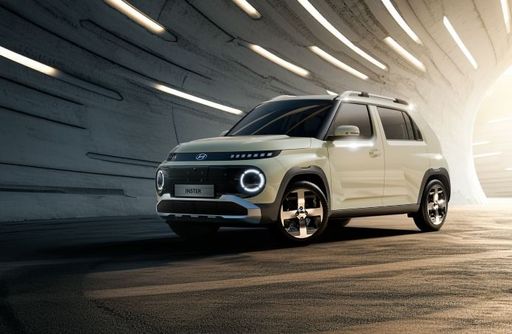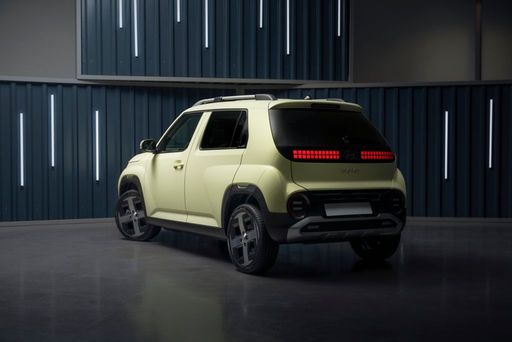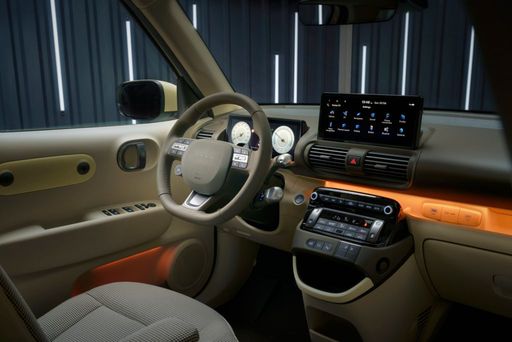Renault Trafic Transporter VS Hyundai Inster – Specs, Efficiency & Price Comparison
Find out now which car fits your needs better!
The Renault Trafic Transporter (Cargo Van) is powered by a Diesel or Electric engine and comes with a Manuel or Automatic transmission. In comparison, the Hyundai Inster (SUV) features a Electric engine and a Automatic gearbox.
When it comes to boot capacity, the Renault Trafic Transporter offers , while the Hyundai Inster provides 280 L – depending on what matters most to you. If you’re looking for more power, you’ll need to decide whether the 170 HP of the Renault Trafic Transporter or the 115 HP of the Hyundai Inster suits your needs better.
There are also differences in efficiency: 21.30 kWh6.70 L vs 14.30 kWh. In terms of price, the Renault Trafic Transporter starts at 33200 £, while the Hyundai Inster is available from 20500 £.
Compare all the key specs now and find out which model fits your lifestyle best!
Renault Trafic Transporter
The Renault Trafic Transporter is a versatile vehicle known for its spacious interior and functional design, ideal for both business and personal use. Its stylish exterior combined with practical features offers a perfect balance between form and function, making it a popular choice among van enthusiasts. The driving experience is enhanced by its smooth handling and advanced technology, providing comfort and convenience for any journey.
detailsHyundai Inster
The Inster has quickly captured the attention of automotive enthusiasts with its striking design and dynamic performance. This model seamlessly blends advanced technology with comfort, making it an ideal choice for both daily commutes and adventurous road trips. With its spacious interior and innovative features, the Inster promises an exhilarating driving experience that doesn’t compromise on practicality.
details @ hyundai.news
@ hyundai.news
 @ hyundai.news
@ hyundai.news
 @ hyundai.news
@ hyundai.news

|
|
|
|
|
Costs and Consumption |
|
|---|---|
|
Price
33200 - 52500 £
|
Price
20500 - 25800 £
|
|
Consumption L/100km
6.7 - 7.8 L
|
Consumption L/100km
-
|
|
Consumption kWh/100km
21.3 - 21.5 kWh
|
Consumption kWh/100km
14.3 - 15.1 kWh
|
|
Electric Range
289 - 292 km
|
Electric Range
327 - 370 km
|
|
Battery Capacity
-
|
Battery Capacity
42 - 49 kWh
|
|
co2
0 - 206 g/km
|
co2
0 g/km
|
|
Fuel tank capacity
80 L
|
Fuel tank capacity
-
|
Dimensions and Body |
|
|---|---|
|
Body Type
Cargo Van
|
Body Type
SUV
|
|
Seats
3 - 6
|
Seats
4
|
|
Doors
4
|
Doors
5
|
|
Curb weight
1885 - 2058 kg
|
Curb weight
1380 - 1433 kg
|
|
Trunk capacity
-
|
Trunk capacity
238 - 280 L
|
|
Length
5080 - 5480 mm
|
Length
3825 - 3845 mm
|
|
Width
1956 mm
|
Width
1610 mm
|
|
Height
1967 - 2509 mm
|
Height
1575 - 1610 mm
|
|
Payload
878 - 1185 kg
|
Payload
317 - 357 kg
|
Engine and Performance |
|
|---|---|
|
Engine Type
Diesel, Electric
|
Engine Type
Electric
|
|
Transmission
Manuel, Automatic
|
Transmission
Automatic
|
|
Transmission Detail
Schaltgetriebe
|
Transmission Detail
-
|
|
Drive Type
Front-Wheel Drive
|
Drive Type
Front-Wheel Drive
|
|
Power HP
110 - 170 HP
|
Power HP
97 - 115 HP
|
|
Acceleration 0-100km/h
10.8 - 15.1 s
|
Acceleration 0-100km/h
10.6 - 11.7 s
|
|
Max Speed
110 - 178 km/h
|
Max Speed
140 - 150 km/h
|
|
Torque
245 - 380 Nm
|
Torque
147 Nm
|
|
Number of Cylinders
4
|
Number of Cylinders
-
|
|
Power kW
81 - 125 kW
|
Power kW
71 - 85 kW
|
|
Engine capacity
1997 cm3
|
Engine capacity
-
|
General |
|
|---|---|
|
Model Year
2022 - 2023
|
Model Year
2025
|
|
CO2 Efficiency Class
G, A
|
CO2 Efficiency Class
A
|
|
Brand
Renault
|
Brand
Hyundai
|
Renault Trafic Transporter
The Renault Trafic Transporter: A Modern Workhorse Unveiled
Renault has consistently set benchmarks in the world of commercial vehicles, and the Renault Trafic Transporter stands as a testament to its innovation and engineering prowess. With a robust design and a variety of configurations, this model addresses the diverse needs of modern businesses. Let’s delve into the technical details and innovative features that make the Renault Trafic Transporter a standout choice in its segment.
Power and Performance
The Renault Trafic Transporter is powered by a choice of 2.0-litre diesel engines boasting power outputs ranging from 110 to 170 PS (81 to 125 kW). The torque delivery is impressive, with figures ranging from 245 to 380 Nm, ensuring ample pulling power for heavy loads. For those seeking an environmentally friendlier option, Renault offers the Trafic with a 100% electric motor delivering 122 PS, a noteworthy addition to its line-up.
Efficient Fuel Consumption
When it comes to fuel efficiency, the diesel variants of the Renault Trafic maintain a commendable consumption range of 6.7 to 7.8 litres per 100 km. Meanwhile, the electric model showcases a consumption of 21.3 kWh per 100 km, with an electric range that stretches up to 292 km. This efficiency places it favourably within the CO2 efficiency classes from A to G.
Robust and Versatile Design
Versatility is at the heart of the Renault Trafic Transporter’s design ethos. With a wide range of body styles available, including options for an extended height or length, businesses can tailor the vehicle to meet their specific transport requirements. The vehicle offers configurations supporting 3 to 4 doors and a payload capacity that ranges from 867 to 1185 kg, ensuring adaptability to a broad spectrum of logistical challenges.
Advanced Features and Innovation
Inside, the Renault Trafic Transporter features a driver-focused cockpit, equipped with modern conveniences such as a multifunction steering wheel and an intuitive dashboard. The available Ecoline, Komfort, and Komfort EDC equipment lines offer varying levels of comfort and technology, ensuring a fit for every budget and preference.
Safety and Connectivity
Renault has prioritised safety in the Trafic Transporter, equipping it with advanced driver assistance systems and connectivity features to keep drivers connected and secure on the road. These innovations not only enhance the driving experience but also contribute to safer business operations.
Conclusion: A Smart Investment for Businesses
With its variety in configurations, impressive powertrains, and focus on efficiency, the Renault Trafic Transporter emerges as a leading choice for businesses nationwide. Whether navigating urban deliveries or long-distance hauls, this transporter provides the reliability and customization that modern enterprises demand, making it an investment well worth considering.
Hyundai Inster
The automotive landscape continues to evolve, and at the forefront of this transformation is the Hyundai Inster, a dynamic model set to impress electric vehicle enthusiasts. As a compact SUV, the Inster embodies a blend of innovative technology, user-friendly features, and an eco-conscious design, making it a contender in the burgeoning electric vehicle market.
Powertrain and Performance
The Hyundai Inster is powered by an efficient electric drivetrain, offering two main battery options: a 42 kWh and a 49 kWh version. These options translate to power outputs of 97 HP and 115 HP, respectively, allowing drivers to choose based on their performance needs. The Inster accelerates from 0 to 100 km/h in 11.7 seconds for the 42 kWh variant, while the more powerful 49 kWh model reaches the same speed in an impressive 10.6 seconds, showcasing Hyundai's commitment to delivering engaging performance.
Range and Efficiency
One of the standout features of the Inster is its electric range. The 42 kWh model provides a range of 327 km, while the 49 kWh variants extend the range to 360 km and 370 km. This remarkable efficiency is complemented by consumption figures of 14.3 kWh/100 km for the 42 kWh variant and 14.9 kWh/100 km for the 49 kWh options. These figures ensure that the Inster is not only suited for city driving but also capable of handling longer journeys with ease.
Dynamic Design and Comfortable Interior
Aesthetically, the Hyundai Inster boasts a sleek and modern look, featuring a compact SUV profile that is both sporty and practical. The dimensions, measuring between 3825 mm and 3845 mm in length, with a width of 1610 mm and heights ranging from 1575 mm to 1610 mm, contribute to its spacious and comfortable cabin. The interior accommodates up to four passengers, making it an ideal choice for small families or couples.
Innovative Features
The Inster incorporates advanced technology geared towards enhancing the driving experience. Its automatic transmission, utilizing a reduction gearbox, ensures seamless gear shifts. Additionally, drivers will appreciate the array of smart features designed for convenience and connectivity, including advanced infotainment systems and driver assistance technologies.
Sustainability Credentials
Hyundai is dedicated to sustainability, and the Inster is a testament to this philosophy. With a carbon footprint of zero emissions, the Inster falls into the A CO2 efficiency class, making it a responsible choice for eco-conscious consumers. The absence of traditional emissions positions the Inster not only as an economical option but also as a proactive step towards reducing our environmental impact.
Conclusion
The Hyundai Inster stands out as a versatile and innovative solution in the electric vehicle segment. With a balanced approach to performance, efficiency, and sustainability, it caters to the modern driver’s needs and reflects the automotive industry's shift towards electrification. The future looks bright for the Inster, as Hyundai continues to pave the way for greener driving experiences.
The prices and data displayed are estimates based on German list prices and may vary by country. This information is not legally binding.
